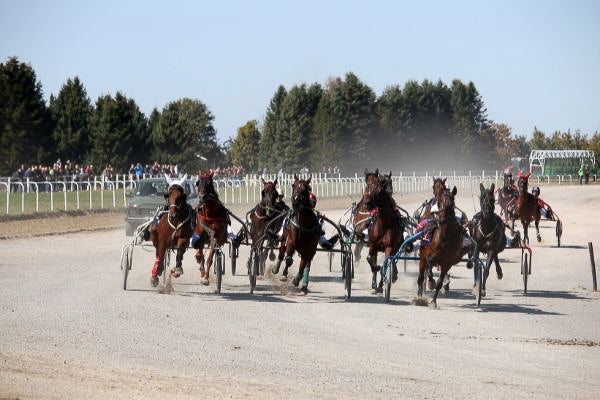
The horses – when the mare’s hormones make themselves felt!
A loud squeak echoes across the paddock. Spring, with warmer temperatures and more daylight, noticeably brings out the mare's hormonal balance again. Many horse owners then talk about the animals' bitchy or ticklish characteristics, which can make handling and sometimes even riding difficult. Others, on the other hand, hardly notice that their horse is having a good time. In fact, this circumstance varies from animal to animal. In any case, there are interesting facts that make the topic quite extensive. We have summarized the most important details for you.
The horses - definition
It is an indication of the possibility of conception or Readiness of the female horse to mate. Many mares show symptoms that are easily recognizable to the stallion, such as: b. the flashing (opening and closing of the pubic area under the tail).
As already mentioned above, this condition in horses is triggered by hormones. These are produced by follicles in the ovary. Ovulation occurs towards the end of pregnancy. The egg cell detaches from the mature follicle. From there it travels via the fallopian tube into the uterus. This period is the late Rosse. Ideal for having a broodmare bred by a stallion or inseminated by a veterinarian if you want a foal. Successful result: Pregnant mare.
If the horse is not covered, everything will go back to normal and the mare will get red again at normal intervals.
Duration of the “state of emergency”
The length of the horses varies from around 3 - 7 days. In the regular course, the cycle repeats itself every 21 days. During the dark winter months, the animal does not show any pronounced horse characteristics. new follicles usually do not form. This is because the cycle is at rest due to the limited daylight.
The very first “horseiness” appears at around two to two and a half years. From this point onwards sexual maturity begins. Once a horse has reached a proud age, horse behavior is often no longer noticed throughout the year.
This is how you recognize the steeds on a horse
Symptoms:
- increased urine release
- Standing with hind legs spread apart
- Tail lifting or putting the tail to the side
- Flashing (see above)
- mucous discharge
- possibly. Behavioral problems e.g. b. bitchy, clingy, ticklish, tense etc.
- Signs increase when breeding stallion is nearby
These horse characteristics vary from horse to horse.
In order to test whether a broodmare is in the breeding season, a test stallion is used in stud farms, for example. It is not uncommon for horses to even react to geldings or other mares with symptoms.
If the animal is inseminated and not bred naturally, the veterinarian must routinely examine the uterus with an ultrasound.
In this way, the exact cycle status can be determined as well as the time when the animal becomes red.
Interesting and important:
Even the mare that is already pregnant may initially show signs of horse behavior. However, ovulation is suppressed during pregnancy.
If the broodmare has been pregnant for a long time, the veterinarian should always carry out a pregnancy examination in order to promptly identify a possible loss of foal.
The horses are missing
- age-related
- Silent horse behavior (normal cycle, but hardly any noticeable symptoms)
- a horse that is too lean or too fat (attention: the nutritional status also regulates it!)
- pathological changes (cysts, tumors)
Important:
If you have any doubts, it makes sense to visit the vet.
If a healthy animal (e.g. b. a broodmare) not in heat can possibly be treated with hormones. be helped.
Too much of a good thing
Unfortunately, there are also mares whose behavioral patterns are very extreme while riding. These animals then appear unfocused, constantly under pressure, defensive and even stubborn under the saddle.
In major sports, means are sometimes used to suppress the recurring cycle pattern.
First, however, it is important to rule out that other influences have triggered this "misbehavior", e.g. b. Inappropriate equipment, rider mistakes or pain in the back or limbs.
Once this has been clarified, the following options are available to throttle the “too much”:
- Hormone treatment (e.g. b. Regumate)
- Immunization (vaccine specifically stops the cycle)
- alternative medicine with homeopathy or herbal science (e.g. b. Chasteberry)
- surgical removal of the ovary
- Place vitreous implant
Explanation:
The monk's pepper is often fed during hormonal fluctuations. It reduces sexual drive and has a balancing effect on the horse. You can also find monk's pepper under the name chaste mud or chaste tree. It was already known in the Middle Ages for its libido-suppressing effect.
Advantage:
Chasteberry is freely available, plant-based and does not harm the animal.
Disadvantage:
In extreme cases it may not be enough.
So if more is needed, many equestrian athletes turn to Regumate. The hormone preparation is often used on horses with persistent horse behavior. This means the services can continue to be provided.
Advantage:
The Regumate is a quick solution for a short period of time and can be self-administered by the owner.
Disadvantage:
Expensive for long-term use and actually not recommended as long-term medication.
The vaccination is not yet that mature in this country. There is still a lack of data on side effects and whether subsequent fertility is influenced by them.
The implant is simply a glass ball. This is inserted into the mare's uterus by the veterinarian shortly after mating. The following steeds are missing.
Advantage:
Simple, long-term and cheap solution without chemicals. Can be removed by the doctor at any time.
Disadvantage:
Only approx. 66-70% of mares react to this.
Lastly the OP.
Advantage:
The permanent lesion is removed and tumor and cyst formation in the ovarian area is no longer possible.
Disadvantage:
Expensive and a surgical procedure is also a risk for the animal!
Conclusion
If you notice an "extra" sex drive in your four-legged friend, you don't have to resort to chemicals straight away. For many mares, the administration of monk's pepper flowers is often sufficient, e.g. b. To get mood swings under control. The following applies: If possible, consult your veterinarian beforehand to rule out illnesses! If he knows your horse well, he can certainly help you with the right methodology.
"Horse(wo)menlike" would also be if you simply take it slower with your little horse during horse time. After all, understanding is part of a good partnership.
Discover more posts

DIY fly spray – natural help against annoying pests
Blue skies and bright sunshine make our riders' hearts beat faster. In this weather you'll definitely want to get started right away, right? Unfortunately, the horses can only share ...
Continue reading
Trotters – fast racehorses with a wide range of talent
It's impressive what trotters, including the sulky and driver, can do in horse racing. They give everything and reach 45 - 50 km/h at a trot. Some of our private horses can't even do this at a...
Continue reading
